Decorating the walls in the bathroom: design options and practical tips
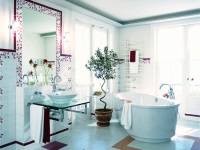
You became the owner of a new apartment, or you just wanted to update your interior design in the bathroom? You do not want to overpay and decided to do everything yourself? Getting lost in a huge selection of materials?
The information in our article will help to orient.
How to choose a material for finishing walls
Bathroom is a room that has its own specific properties, which simply can not be ignored when carrying out repair work. The most important of them is the presence of humidity in the room, the lack of good ventilation and the impact of various aggressive detergents and cleaners.
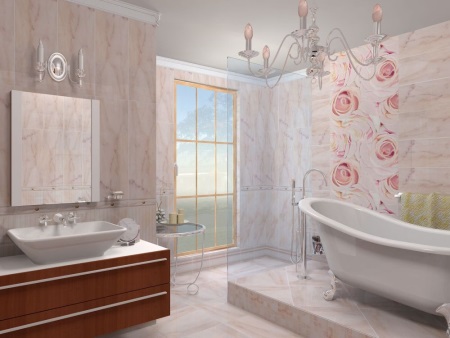
In conditions of high humidity feel comfortable fungi and bacteria, which are happy to be your neighbors. In addition, the room bathrooms are usually small, so it is very important to use durable materials for decoration, to prevent accidental damage by any objects (basins, buckets, etc.). Thus, the materials to be used in finishing the walls of the bathroom should have the following properties:
- moisture resistance
- resistance to chemical attack
- Absence of a breeding ground for fungi and bacteria
- strength
- durability
- easy care
- decorative effect.
Preparing the walls for finishing
Before making repairs, the following factors must be taken into account:
- The condition of the walls in the room. They must have an even surface. How perfect this must be done, depends on the material with which you plan to make the finishing. If smooth coil materials or paint will be used, then there should not be the slightest imperfection visible on the wall. If it will be tile or wall panels, then small irregularities will not prevent a quality repair.
- The presence of old finishes. So, if the walls are already covered with tile, then it is necessary to remove it, and the remaining adhesive for laying tiles should be carefully cleaned from the surface. This is a very long and time-consuming process. If the walls are painted, the paint can be left on, but depending on the new wall finishing materials, you may need to use a primer.
- On oil-based paint, for example, putty and tiles do not adhere well, on smooth concrete - plaster, but using the primer forms a rough tough film and there is a good adhesion of materials. This is the fastest way to prepare walls for subsequent finishing, as it does not involve complete cleaning of the surface of the old coating.
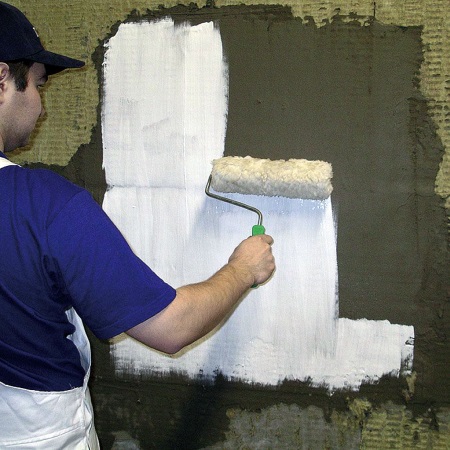
To protect bathroom walls from fungus, it is also recommended to treat them with antiseptic. It will be much cheaper than trying to get rid of it later. Sometimes it is simply impossible to do this.
The choice of materials for finishing
For finishing the bathroom room, the choice of materials is huge, so let's just list them:
- Paint
- Ceramic tile
- Mosaic
- Porcelain tiles
- Wallpaper
- Plastic panels
- Decorative plaster
- Mirror tiles
- Agglomerate
- Marble
- Wood
Next, let's take a closer look at each of the finishing materials.
Ceramic Tile
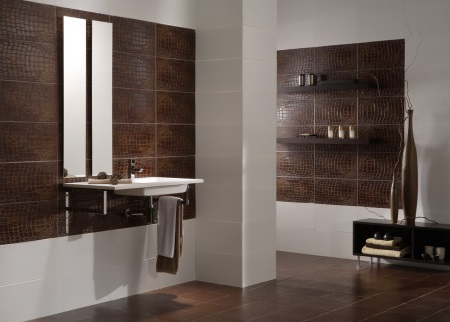
Laying tiles on the wall of the bathroom - this is the most common type of repair, is a classic option. The choice of tiles by color, size, texture is huge. There are various inserts, decors, borders, panels that help give individuality to the bathroom. Taking care of it is also quite simple.
To the disadvantages of this type of material can be attributed a large monetary and labor costs, as well as, oddly enough, durability.
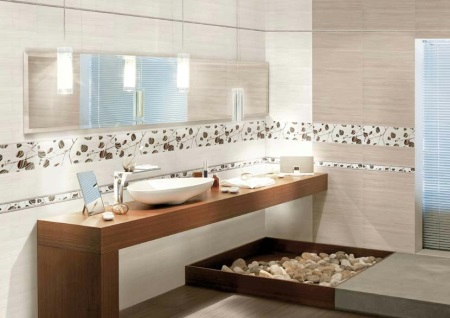
Every year there are few people willing to lay tiles in the bathroom, so you need to take its choice seriously. Are you sure that the bright animalistic print on the wall will still give you pleasure in two years, or in five years? Then you should opt for calmer, classic colors and patterns. Shades of beige, blue, green will never go out of style.
Read more in our article about bathroom tile design.
Porcelain stoneware
Porcelain tile is a modern competitor to ceramic tiles. It is much stronger and more durable than ceramic tiles. This material produces the best imitation of natural stone, which is important for original design solutions.
The disadvantages Porcelain tiles can be attributed only a higher price than conventional ceramic tiles.
Porcelain tiles - Is an environmentally friendly material, which by its performance characteristics surpasses natural stone. It does not harbor microorganisms.
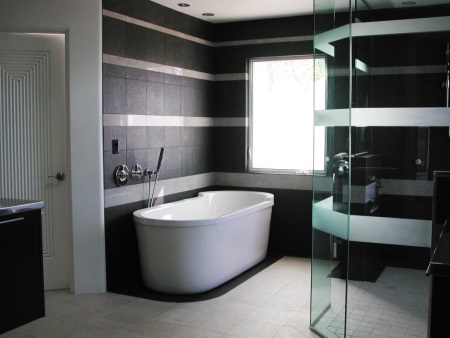
Plastic panels
A suitable material for bathrooms is plastic. It is not afraid of water and temperature differences, does not fade, can withstand heavy loads. That is why PVC panels are very popular. Their advantages include convenience, ease and speed of installation, as well as the almost total absence of dirt during repairs.
With the coating of walls with plastic panels can cope any novice master. With their help, you can easily create an original interior.
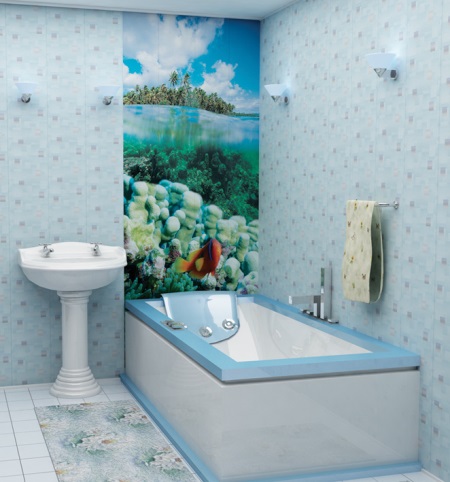
For example, by alternating several colors, you get a striped decor. They can be fastened not only horizontally, but also vertically and even diagonally. The disadvantages of plastic panels include the formation of condensation on it and their instability to mechanical damage, as well as the need to assemble a crate before installing them.
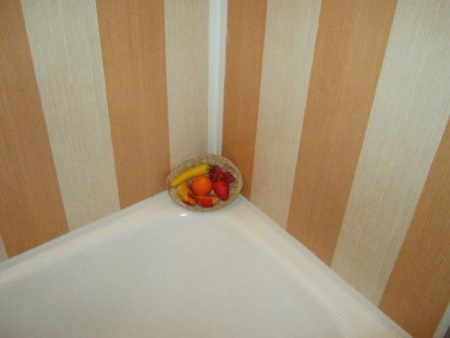
Read more in our article about plastic panels for the bathroom.
Wall painting - easy and practical
Painting the walls in the bathroom is the oldest, but has not lost relevance, method of repair. The main thing is to choose the appropriate paint that is not afraid of water. Best suited for this purpose are latex or water-dispersion acrylic paints.
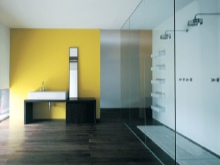
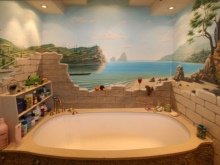
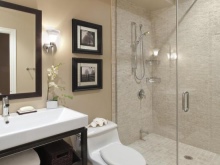
Painting should be performed in 2-3 layers.
Look original walls, painted in different colors.
And if you have drawing skills, you can try to draw your own plot. If not - you can buy ready-made stencils.
The main disadvantage of painting is a long and thorough preparation - It is necessary to perfectly level the surface of the walls. But to take care of painted surfaces is easy and simple.
Wallpaper for the bathroom - original, but not durable
Yes, that's right! Wallpaper is glued even in bathrooms. This, of course, is not an ordinary paper wallpaper, and moisture-resistant. For example, vinyl, acrylic or glass wallpaper.
On rolls of such wallpaper is a special sign in the form of three waves, indicating that they can be used in wet rooms.
The choice of such wallpaper is impressive, they require minimal care, glue quickly, but they have a weak point: the joints. They very often get moisture, so you can't count on the durability of such repairs.
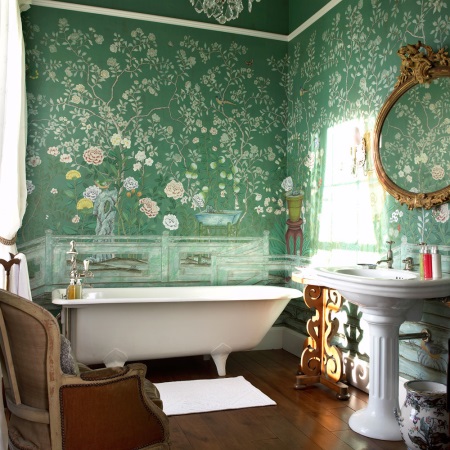
Drywall - easy, cheap, but tight
Recently, for finishing walls in bathrooms, special plasterboard is used - moisture-resistant. It is distinguished from the usual one by its green color. The use of gypsum board does not require special preparation of the walls, it is easy and quick to install, has good sound and thermal insulation, and is inexpensive. It would seem to be an ideal option, but it is not without its drawbacks.
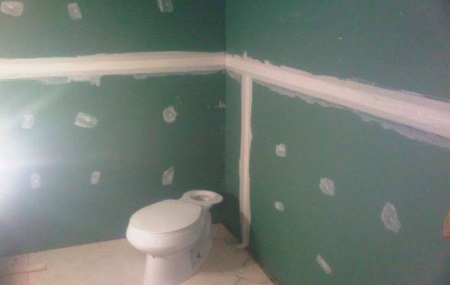
Mounting drywall requires fixing profiles on the walls, and this reduces the size of the room, which is critical for small standard bathrooms in our country. In addition, plasterboard itself has an unaesthetic appearance and requires additional costs to cover with other materials.
Decorative plaster - design decoration of walls
If you do not want to be like everyone else, but like an individual approach, then you should pay attention to such design wall decoration as decorative plaster. It used to be used only in living rooms, but now it is also appropriate in bathrooms. The properties of plaster are such that it is not afraid of moisture and has a high absorption capacity. Water vapor will no longer hang in the air, and no condensation will form on mirrors and furniture. Decorative plaster can be flat or textured, has no seams, is attractive and unique.
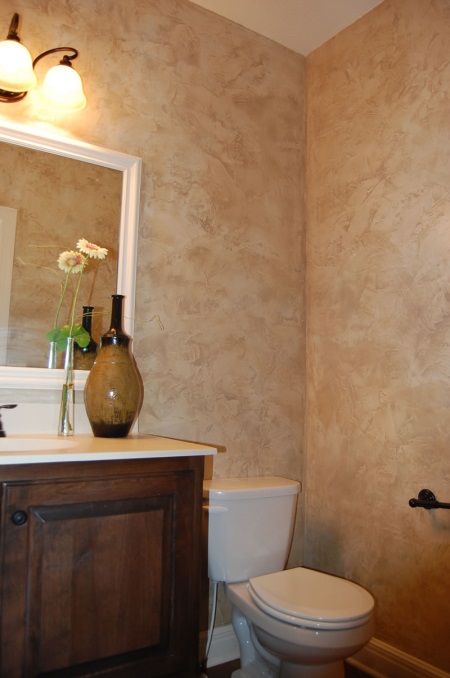
Natural materials in decoration
Connoisseurs of naturalness when finishing walls will pay attention to such natural materials as wood, marble and natural stone. Using wooden coverings will remind you of a sauna or rustic bathhouse. However, wood is prone to rot, so for it to last a long time, it must be treated with antiseptic impregnation or water repellent.
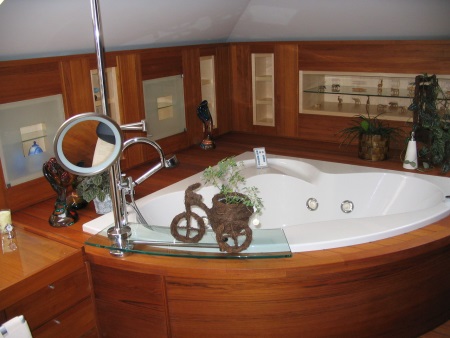
Decorating the walls of marble and natural stone will give the bathroom color of the primitive dwelling or a Roman bath, but this material - capricious and requires careful attention. Among other things, it is very expensive.
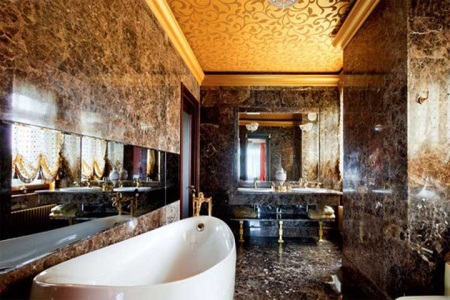
Alternative wall design materials
One of the new materials in interior decoration has become agglomerate - artificial stone. It consists of both natural (marble, quartz, feldspar) and artificial components (plastic, resin). When heated above 600 ° C, this material becomes similar in properties to plasticine and they can easily produce finishing surfaces of the most complex configurations. The disadvantages of this material include only its high cost.
Agglomerate has high strength, resistance to damage, beautiful texture and is very easy to care for.
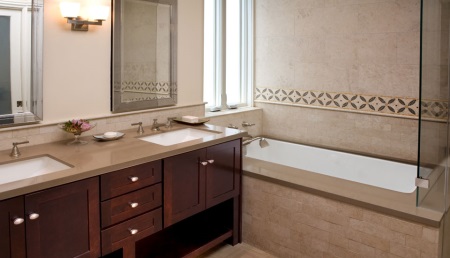
An unusual and beautiful material for finishing bathrooms is mosaic. It can be not only stone or ceramic, but also metal or glass, so it is one of the favorite materials of decorators. According to your sketch on the computer will collect a drawing of any kind and size. Of the disadvantages - expensive and long, time-consuming process of application. But your bathroom will be a real masterpiece.
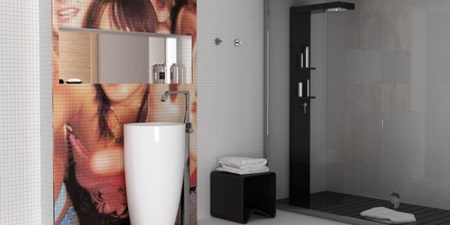
Mirrors are also a favorite material of designers. They make the room appear larger, lighter, and more airy.
For the decoration of bathrooms, either mirrored cloths or tiles are used. They are made of moisture-resistant glass with a thickness of about 5 mm and have different shapes and sizes. Of the disadvantages - this material is demanding to care.
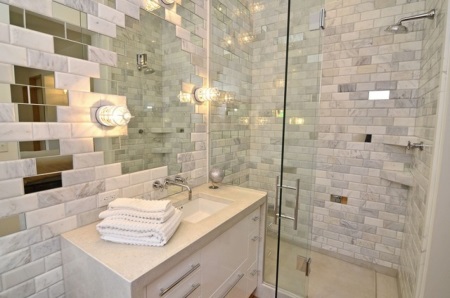
Another unusual material in the finishing of bathrooms has become a self-adhesive film. This is a very cheap coating, but it is not easy to glue it qualitatively, very often it blows up in bubbles and has an unpresentable appearance.

Read more in our article about Self-adhesive foil and bathroom stickers.
How to combine materials correctly - ideas from designers
To give individuality to the bathroom, try to implement original ideas from designers. For example, to combine several finishing materials in the interior:
Option 1. The walls in the room are covered with paint, and ceramic tiles are laid on the space around the bathtub and sink. The form of laying can be varied: stepped, square, rectangular.
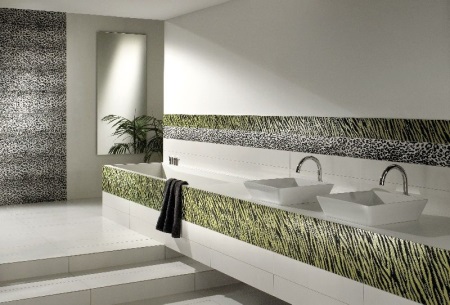
Option 2. The lower part of the bathroom walls is covered with plastic panels, and the upper part is painted or wallpapered. The panels are also attached to the wall surface near the bathtub.
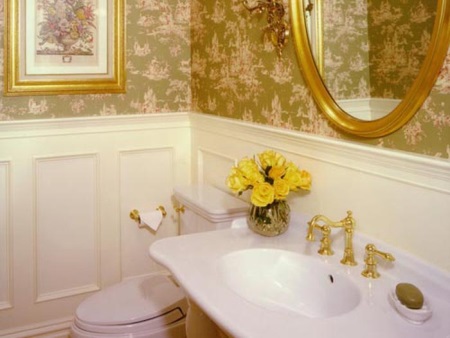
Option 3. The walls, where the sink and bathtub are, are finished with mosaic tiles, on the dry wall - wallpaper.
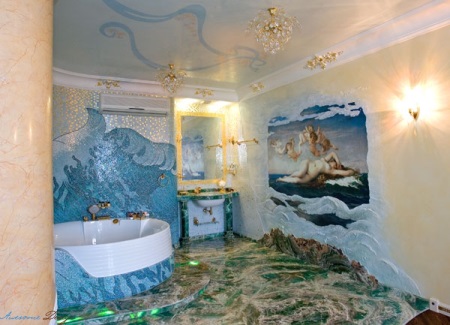
Option 4. Zoning the space by using different in color and size tiles from the same collection.
About other options for zoning, read our article on design of the combined bathroom.
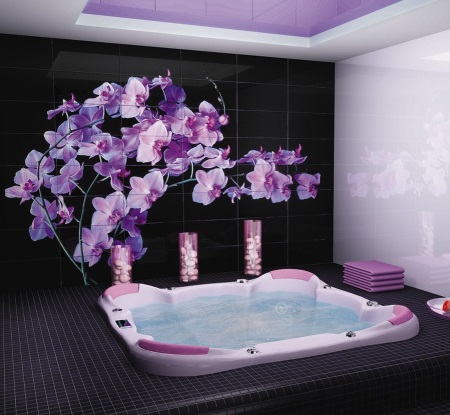
Option 5. The walls are finished with ceramic tiles with mirror inserts.
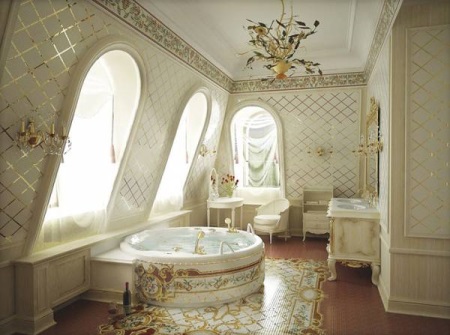
It is impossible to describe all variations, as it is impossible to stop the flight of human imagination. Experiment, fantasize, bring to life! And then the bathroom will be your pride and the object of admiration of your guests.

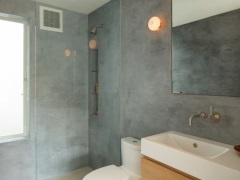
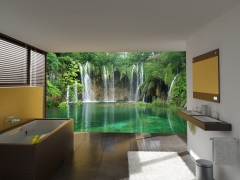
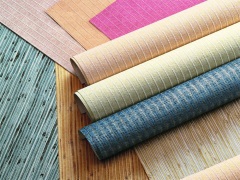
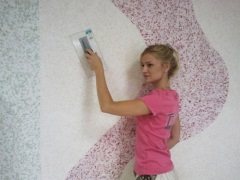
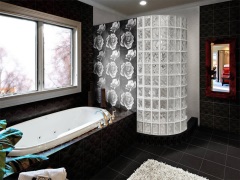
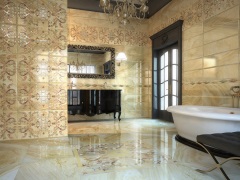
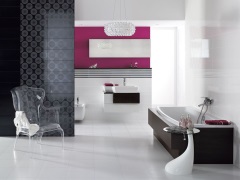
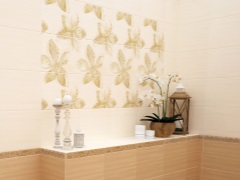
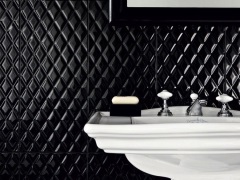
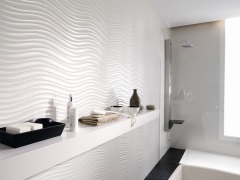
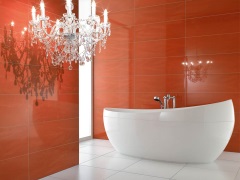
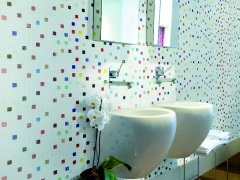
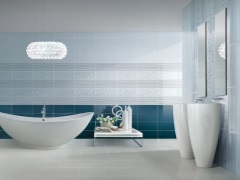
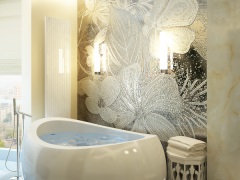

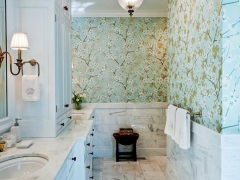
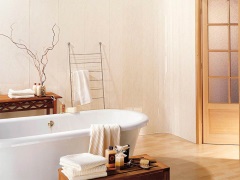
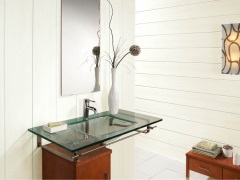
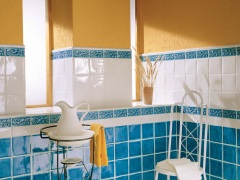
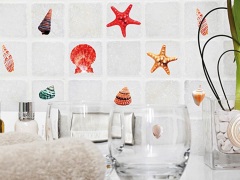
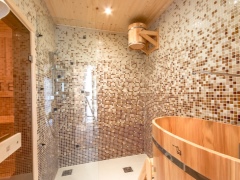
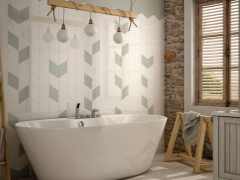
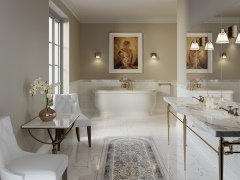
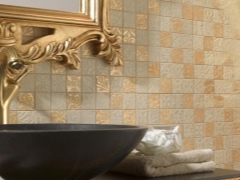
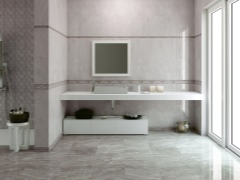
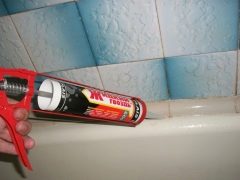
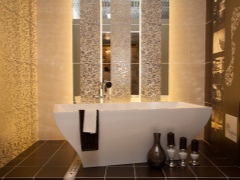

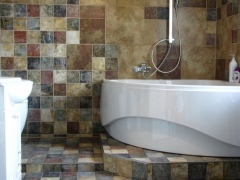
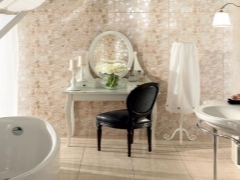
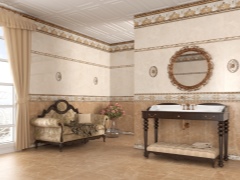
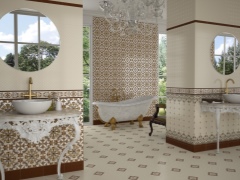
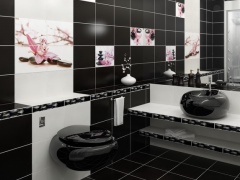
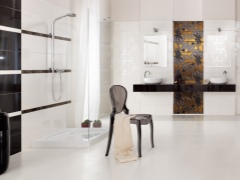
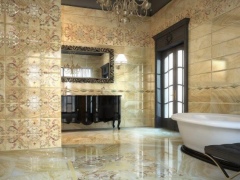
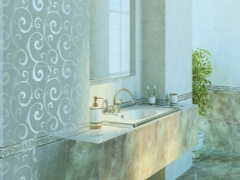
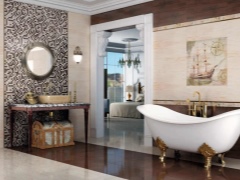
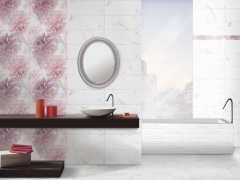
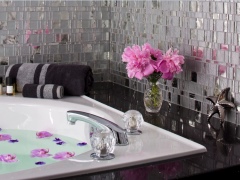
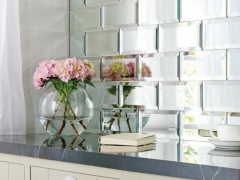
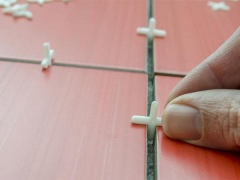
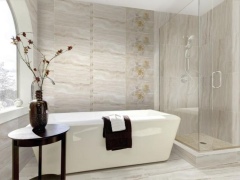
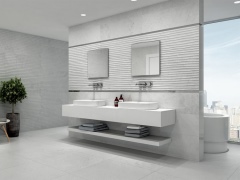
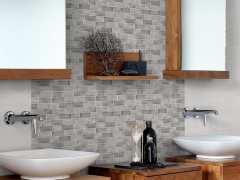
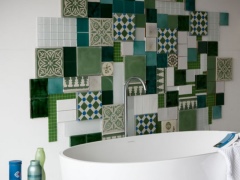
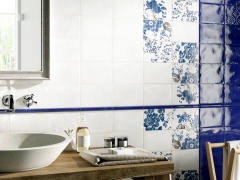
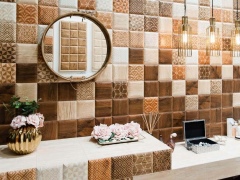
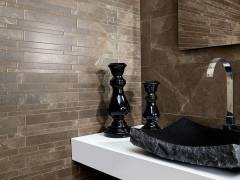
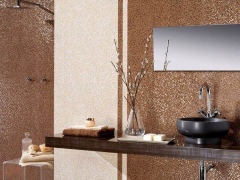
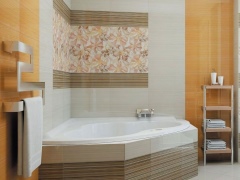
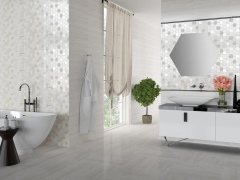
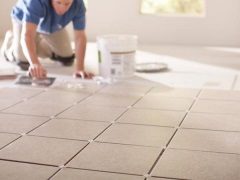
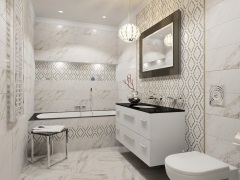
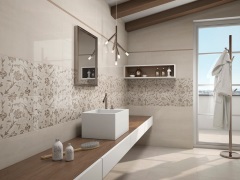
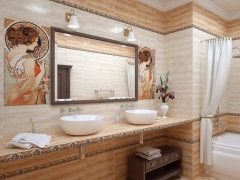
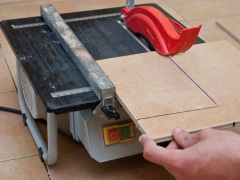
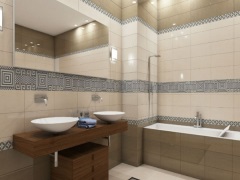
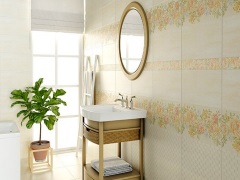
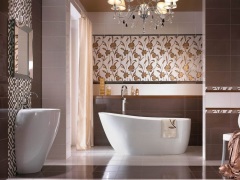
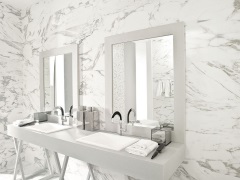
I'm going to put porcelain stoneware on the floor and ceramic tiles on the walls. Seems like the perfect option to me.